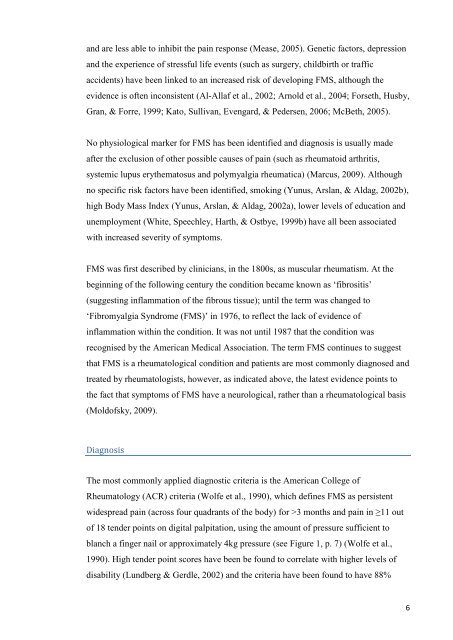Sick and Tired: Understanding and Managing Sleep Difficulties in ...
Sick and Tired: Understanding and Managing Sleep Difficulties in ...
Sick and Tired: Understanding and Managing Sleep Difficulties in ...
Create successful ePaper yourself
Turn your PDF publications into a flip-book with our unique Google optimized e-Paper software.
<strong>and</strong> are less able to <strong>in</strong>hibit the pa<strong>in</strong> response (Mease, 2005). Genetic factors, depression<br />
<strong>and</strong> the experience of stressful life events (such as surgery, childbirth or traffic<br />
accidents) have been l<strong>in</strong>ked to an <strong>in</strong>creased risk of develop<strong>in</strong>g FMS, although the<br />
evidence is often <strong>in</strong>consistent (Al-Allaf et al., 2002; Arnold et al., 2004; Forseth, Husby,<br />
Gran, & Forre, 1999; Kato, Sullivan, Evengard, & Pedersen, 2006; McBeth, 2005).<br />
No physiological marker for FMS has been identified <strong>and</strong> diagnosis is usually made<br />
after the exclusion of other possible causes of pa<strong>in</strong> (such as rheumatoid arthritis,<br />
systemic lupus erythematosus <strong>and</strong> polymyalgia rheumatica) (Marcus, 2009). Although<br />
no specific risk factors have been identified, smok<strong>in</strong>g (Yunus, Arslan, & Aldag, 2002b),<br />
high Body Mass Index (Yunus, Arslan, & Aldag, 2002a), lower levels of education <strong>and</strong><br />
unemployment (White, Speechley, Harth, & Ostbye, 1999b) have all been associated<br />
with <strong>in</strong>creased severity of symptoms.<br />
FMS was first described by cl<strong>in</strong>icians, <strong>in</strong> the 1800s, as muscular rheumatism. At the<br />
beg<strong>in</strong>n<strong>in</strong>g of the follow<strong>in</strong>g century the condition became known as „fibrositis‟<br />
(suggest<strong>in</strong>g <strong>in</strong>flammation of the fibrous tissue); until the term was changed to<br />
„Fibromyalgia Syndrome (FMS)‟ <strong>in</strong> 1976, to reflect the lack of evidence of<br />
<strong>in</strong>flammation with<strong>in</strong> the condition. It was not until 1987 that the condition was<br />
recognised by the American Medical Association. The term FMS cont<strong>in</strong>ues to suggest<br />
that FMS is a rheumatological condition <strong>and</strong> patients are most commonly diagnosed <strong>and</strong><br />
treated by rheumatologists, however, as <strong>in</strong>dicated above, the latest evidence po<strong>in</strong>ts to<br />
the fact that symptoms of FMS have a neurological, rather than a rheumatological basis<br />
(Moldofsky, 2009).<br />
Diagnosis<br />
The most commonly applied diagnostic criteria is the American College of<br />
Rheumatology (ACR) criteria (Wolfe et al., 1990), which def<strong>in</strong>es FMS as persistent<br />
widespread pa<strong>in</strong> (across four quadrants of the body) for >3 months <strong>and</strong> pa<strong>in</strong> <strong>in</strong> ≥11 out<br />
of 18 tender po<strong>in</strong>ts on digital palpitation, us<strong>in</strong>g the amount of pressure sufficient to<br />
blanch a f<strong>in</strong>ger nail or approximately 4kg pressure (see Figure 1, p. 7) (Wolfe et al.,<br />
1990). High tender po<strong>in</strong>t scores have been be found to correlate with higher levels of<br />
disability (Lundberg & Gerdle, 2002) <strong>and</strong> the criteria have been found to have 88%<br />
6

















